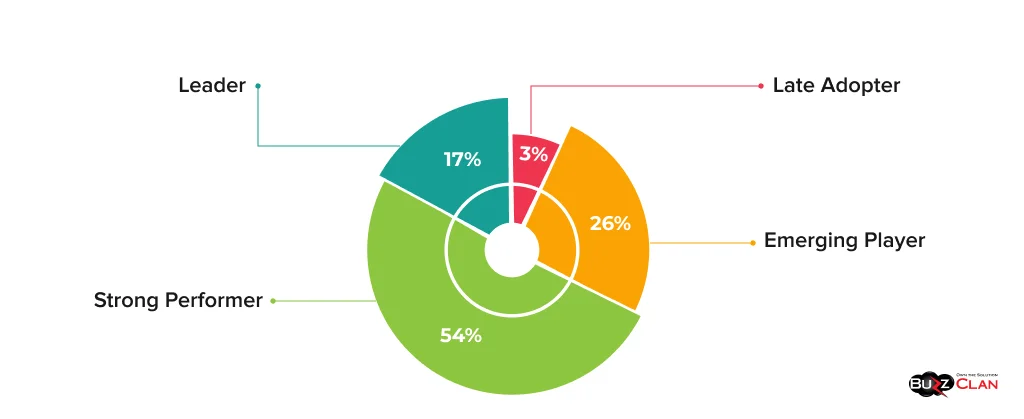Is Your Business Really AI Ready in 2025?
Rohan Rao
Jun 27, 2025
There’s no denying it—AI is everywhere in 2025.
From the boardroom to our workflows and even our coffee machines, AI is making its presence felt more powerfully every day.
It’s no longer something only tech giants care about. AI is now at the center of every forward-thinking organization’s digital transformation agenda, regardless of size or industry.
But here’s the thing: while nearly every business today is eager to tap into AI’s potential, research shows that only 17% of organizations are truly AI-ready.

Being AI ready isn’t just about experimenting with a chatbot or trying out a new analytics tool. It’s about whether your organization has the proper foundation, which is your data, your teams, and your mindset, to make AI work for you in a meaningful way.
In this blog post, we’ll break down what it really means to be AI ready, why it matters more than ever in 2025, and how your business can move from confusion to clarity.
What Does Being AI Ready Actually Mean?
Being AI ready doesn’t just mean having a few AI tools in place or experimenting with machine learning pilots. It means your organization is structurally and strategically equipped to use AI effectively, responsibly, and at scale.
This readiness spans four essential dimensions:
- Strategic Alignment: AI initiatives must be rooted in business value, not just technological ambition. AI ready organizations don’t chase trends; they pursue outcomes.
They identify specific use cases where AI can deliver measurable impact, whether it’s streamlining internal processes, enhancing customer experiences, or unlocking new revenue opportunities.
More importantly, senior leadership plays an active role in defining AI’s place in the business roadmap, ensuring clarity on objectives, key performance indicators (KPIs), and expected return on investment (ROI).
- Data Preparedness:You can’t build successful AI systems without AI ready data because AI is only as good as the data it learns from.
AI ready organizations invest in building robust data foundations with centralized repositories, strong data governance policies, and systems that ensure data is accurate, relevant, and usable.
When data is fragmented, outdated, or lacks context, AI initiatives struggle to deliver value. By investing in clean, well-structured, and AI ready data, businesses create a foundation that enables reliable, scalable, and ethical AI implementation.
- Modern Infrastructure: Outdated systems are one of the biggest roadblocks to digital transformation, especially when scaling AI.
Many businesses still rely on legacy architectures that weren’t built to support the scale, speed, or flexibility that AI workloads demand. AI ready organizations know this and that’s why they invest in modern, cloud-native setups that let them move fast, test ideas, and roll out AI across different teams.
They make sure their tech stack is secure, flexible, and built to handle AI workloads. This includes having the right storage, computing power, and tools that connect easily with the rest of their business systems.
- Building AI Ready Teams: Technology alone isn’t enough. Organizations that are truly AI ready build internal awareness and capability around AI across departments.
This involves upskilling teams, developing cross-functional AI literacy, and cultivating a culture where humans and machines work in a strategic partnership.
Not everyone needs to be a data scientist, but everyone should understand how AI fits into their role and how to use it ethically and intelligently.
AI Adoption Challenges (And Why They Matter)
Being AI ready means having the right ecosystem in place, and that’s where many organizations hit a wall. Here are some of the most common AI adoption challenges that stand in the way:
- Unstructured and Siloed Data: AI thrives on high-quality data, but most organizations are still dealing with messy, siloed, or incomplete datasets. Without clean, structured, accessible, and AI ready data, even the most innovative AI tools won’t deliver meaningful outcomes.
- Lack of Strategic Alignment:Many organizations dive into AI adoption not because they’re ready, but because they feel pressured by industry trends and the need to appear innovative.
It feels like the next big thing, and nobody wants to be left behind. However, when AI projects aren’t tied to clear business goals, they often become expensive experiments instead of long-term value drivers.
- Skills Gaps and Talent Bottlenecks: Building AI systems isn’t just about having data scientists on board. It requires collaboration across teams, including IT, DevOps, and line-of-business leaders. Most organizations struggle with this cross-functional readiness, which is essential for driving end-to-end digital transformation.
- Legacy Infrastructure: One of the biggest challenges organizations face in adopting and implementing AI is outdated infrastructure. Many enterprises are still operating on systems that were never designed with AI workloads in mind. For example, monolithic architectures, siloed data warehouses, or on-premises environments that can’t support real-time processing or the scale AI demands.
AI thrives in environments that are modular, cloud-native, and designed for agility and flexibility. Without this foundation, even the most promising AI initiatives can stall.
- Ethical and Regulatory Concerns: AI adoption comes with real ethical and legal responsibilities. Issues like algorithmic bias, lack of transparency, and data privacy can’t be treated as afterthoughts. If your AI makes a decision, can you explain why it did? Can you ensure it’s fair and compliant?
With evolving regulations, such as the EU AI Act, and growing scrutiny around data use, businesses must embed ethics and compliance into their AI strategy from the outset. Ignoring this can stall implementation—or worse, damage trust and reputation.
Being AI-ready means being accountability-ready too.
Practical Strategies to Become an AI Ready Organization

AI adoption and implementation don’t happen overnight. It requires a phased, thoughtful approach that considers your organization’s current standing and the necessary changes across people, processes, and technology.
Here are some practical strategies to get there:
- Start with Use Case Discovery: Don’t try to “do AI” for the sake of it. Identify specific, high-impact use cases where AI can drive measurable value, such as reducing manual tasks, enhancing customer support, or improving forecasting accuracy.
- Assess and Modernize Your Data Foundation: If your data is siloed, outdated, or poorly governed, prioritize addressing these issues first. Invest in AI ready data, cloud-native platforms, and governance frameworks that can scale.
- Build Cross-Functional AI Teams: Encourage collaboration between business units, IT, and data science teams. AI projects succeed when technical experts and domain leaders work together to frame problems, interpret results, and drive adoption.
- Pilot, Learn, Scale: Start small, but be strategic. Pilot AI in controlled environments, learn from the outcomes, and build reusable patterns that can be scaled across departments.
- Upskill Your Workforce: Equip teams with the right level of AI literacy. This could involve training business users on the capabilities and limitations of AI, offering hands-on workshops for developers, or empowering leadership to make informed, AI-driven decisions with confidence.
- Integrate Responsible AI from Day One: Ensure your strategy includes fairness, explainability, privacy, and compliance. Building responsible AI is foundational to earning trust and maintaining long-term success.
How to Assess Your AI Readiness?
Understanding your current level of AI readiness helps you establish a solid foundation for making informed decisions. Moreover, a thorough assessment helps identify hidden gaps, prioritize where to focus first, and avoid costly investments in the beginning.
Rather than chasing trends or rushing into implementation, evaluate whether the right building blocks are in place, including strategy, data, skills, and governance. The clearer your starting point, the stronger your AI outcomes will be.
Use the checklist below as a quick yet meaningful diagnostic to assess your organization’s current standing.
AI Readiness Self-Assessment Checklist
Scoring Guidance
- 5–6 Yes: You’re likely in a strong position to scale AI responsibly.
- 3–4 Yes: You’re building a good foundation—keep aligning strategy and execution.
- 1–2 Yes: You may be experimenting, but foundational gaps could hold you back.
- 0 Yes: It’s time to step back, align your tech and teams, and build a strategic roadmap.
The Bottom Line
As 2025 continues to reshape digital priorities, the ability to scale AI responsibly and effectively will be a key differentiator.
The question is no longer “Should we use AI?”
It’s “Are we ready to get it right?”










